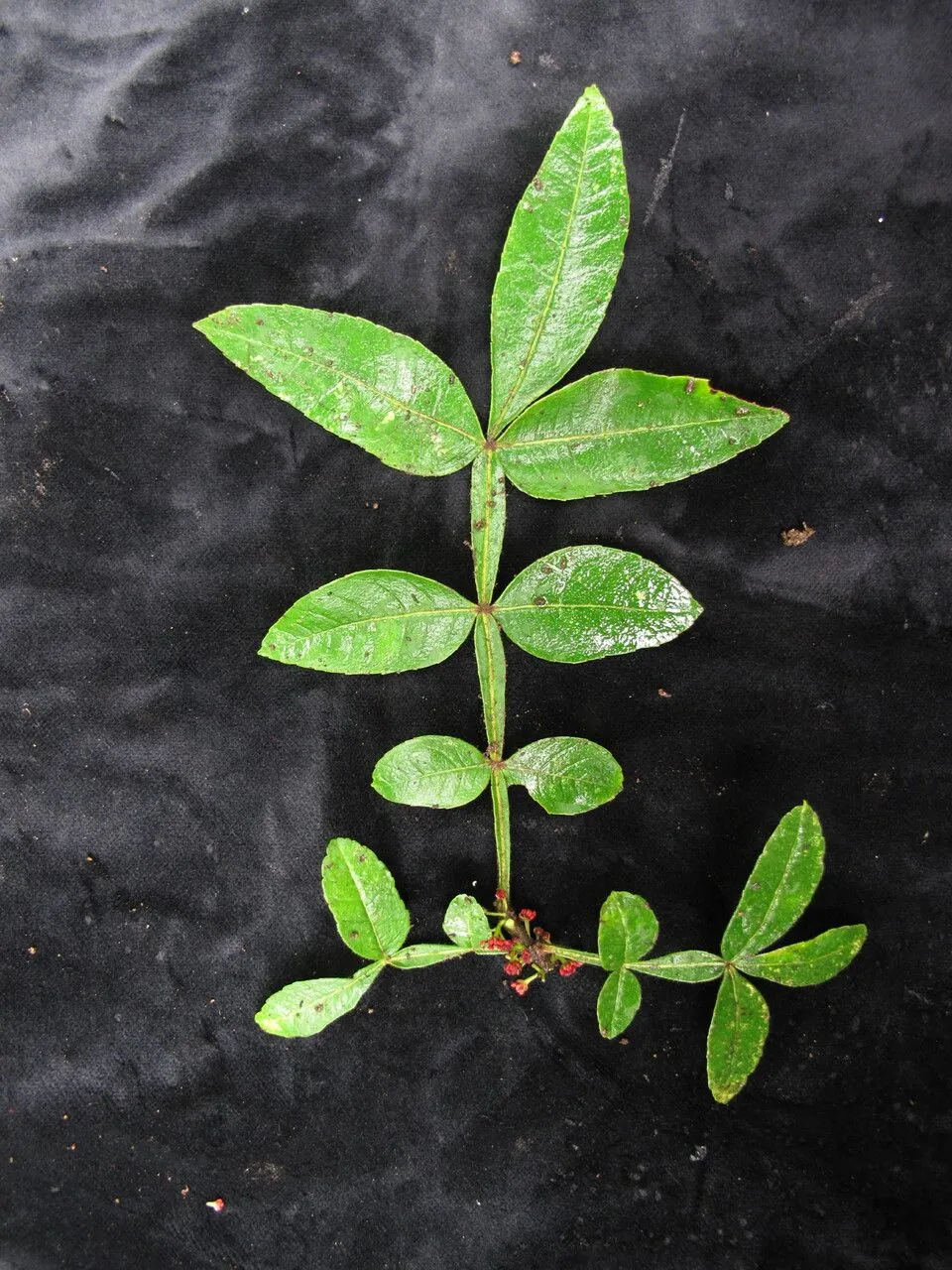
Author: DC.
Bibliography: Prodr. 1:727. 1824
Year: 1824
Status: accepted
Rank: species
Genus: Zanthoxylum
Vegetable: False
Observations: Indian Subcontinent to Temp. E. Asia and Malesia
The Winged prickly-ash (Zanthoxylum armatum) is a notable shrub or small tree that hails from a broad geographical range, spanning the Indian Subcontinent, temperate regions of East Asia, and extending to Malesia. It belongs to the Rutaceae family, distinguished by its significant botanical diversity and relevance.
Zanthoxylum armatum is marked by its characteristic winged stems and branches, which give the plant its common name. The presence of prickles along these wings adds to its unique appearance and provides a measure of defense against herbivores. This species thrives in a variety of climatic conditions, adapting well to both temperate and tropical environments across its native distribution.
The foliage of the Winged prickly-ash exhibits a compound leaf structure typical of the genus, with each leaflet contributing to the overall aromatic quality of the plant, a feature often leveraged in traditional practices. The leaves, when crushed, release a distinctive fragrance that has been utilized in both culinary and medicinal applications.
The plant produces small, greenish-yellow flowers that cluster together, eventually giving way to red or brown fruits. These fruits are not only visually striking but also contain essential oils and compounds valued for their medicinal properties. Traditionally, various parts of Zanthoxylum armatum have been employed in herbal remedies to treat a variety of ailments, from digestive issues to skin conditions.
Ecologically, the Winged prickly-ash plays a crucial role in its native habitats. It serves as a source of food and shelter for various insect species and birds. The prickly structure of the plant provides an effective defense mechanism, giving it an edge in the competitive subtropical ecosystems.
First documented in the botanical literature in 1824, the scientific classification and description of Zanthoxylum armatum were authored by the renowned botanist DC. The detailed observations over the years have highlighted not only its ecological significance but also its versatile uses in traditional medicine and local economies.
In conclusion, Zanthoxylum armatum, or Winged prickly-ash, is a remarkable species with a broad native range and varied applications. Its unique structural characteristics, coupled with its aromatic and medicinal properties, make it a plant of significant interest both botanically and culturally.
Eng: winged prickly-ash
En: Winged prickly-ash, Nepal pepper
Az: Qanadlı zantoksilum
Zh: Zhu ye hua jiao, 秦椒
De: Nepalesischer Sichuanpfeffer, Nepalpfeffer
Ko: 개산초
Ml: തൂമ്പണലരി
Ne: Timur
Zh-tw: 秦椒
Th: หมักก้าก
Taken Aug 15, 2008 by Royal Botanic Garden Edinburgh – Mark Francis Watson (cc-by-nc)
Taken Oct 21, 2021 by Raoul Piccirillo (cc-by-sa)
Taken Jun 17, 2022 by Forêt Vraie (cc-by-sa)
Taken Sep 21, 2021 by Jean Burger (cc-by-sa)
Taken Apr 3, 2020 by Leela Giulia (cc-by-sa)
Taken Aug 11, 2022 by Gabriela Jurkovic (cc-by-sa)
Taken Nov 22, 2020 by André DENIS (cc-by-sa)
Taken Nov 9, 2022 by Max Toulouse (cc-by-sa)
Taken Nov 27, 2022 by jean louis broncard (cc-by-sa)
Taken Sep 21, 2021 by Jean Burger (cc-by-sa)
Taken Jul 14, 1983 by Royal Botanic Garden Edinburgh – Anonymous (cc-by-nc)
Taken Oct 1, 1974 by Royal Botanic Garden Edinburgh – Anonymous (cc-by-nc)
Taken Jun 23, 1967 by Royal Botanic Garden Edinburgh – Anonymous (cc-by-nc)
Taken Jun 24, 1967 by Royal Botanic Garden Edinburgh – Anonymous (cc-by-nc)
Taken Jun 14, 2008 by Royal Botanic Garden Edinburgh – Anonymous (cc-by-nc)
Taken Mar 22, 2019 by Daniel Barthelemy (cc-by-nc)
Taken Mar 22, 2019 by Daniel Barthelemy (cc-by-nc)
Taken Nov 9, 2022 by Max Toulouse (cc-by-sa)
Taken Nov 22, 2020 by Bogdan Nesic (cc-by-sa)
Taken Apr 24, 2020 by Leela Giulia (cc-by-sa)
Taken Sep 17, 2011 by Royal Botanic Garden Edinburgh – Mark Francis Watson (cc-by-nc)
Taken Sep 17, 2011 by Royal Botanic Garden Edinburgh – Mark Francis Watson (cc-by-nc)
Taken Sep 17, 2011 by Royal Botanic Garden Edinburgh – Mark Francis Watson (cc-by-nc)
Taken Sep 17, 2011 by Royal Botanic Garden Edinburgh – Mark Francis Watson (cc-by-nc)
Taken Sep 17, 2011 by Royal Botanic Garden Edinburgh – Mark Francis Watson (cc-by-nc)
© copyright of the Board of Trustees of the Royal Botanic Gardens, Kew.
Family: Myrtaceae Author: (F.Muell.) K.D.Hill & L.A.S.Johnson Bibliography: Telopea 6: 402 (1995) Year: 1995 Status:…
Family: Rubiaceae Author: Pierre ex A.Froehner Bibliography: Notizbl. Bot. Gart. Berlin-Dahlem 1: 237 (1897) Year:…
Family: Sapindaceae Author: Koidz. Bibliography: J. Coll. Sci. Imp. Univ. Tokyo 32(1): 38 (1911) Year:…
Family: Asteraceae Author: A.Gray Bibliography: Pacif. Railr. Rep.: 107 (1857) Year: 1857 Status: accepted Rank:…
Family: Fabaceae Author: Medik. Bibliography: Vorles. Churpfälz. Phys.-Ökon. Ges. 2: 398 (1787) Year: 1787 Status:…
Family: Aspleniaceae Author: (Cav.) Alston Bibliography: Bull. Misc. Inform. Kew 1932: 309 (1932) Year: 1932…